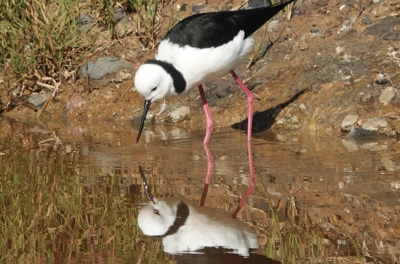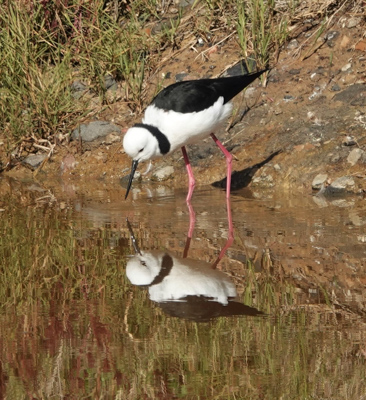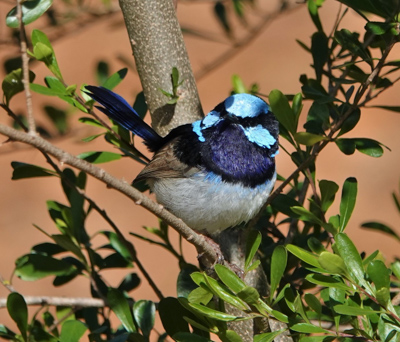Sept 2018 bird survey

The first Black-winged Stilts have appeared after their winter absence on the edge of the drainage basin above the south-east corner of the Saltwater Lake. Lots of male superb Fairy-wrens are now in their breeding plumage.

Black-winged Stilt, photo Andrew McCutcheon 
Superb Fairy-wren, male photo Andrew McCutcheon
By Andrew McCutcheon & Rob Youl, 3 Sept 2018
Weather: mostly fine with a light south wind later in the morning, temp 10C-15C. Entire survey route completed, start time 0900, finish 1315
| Species | No. seen | Species | No. seen |
| Brown Quail | Galah | ||
| Black Swan | 3+4D | Little Corella | |
| Australian Shelduck | Sulphur-crested Cockatoo | ||
| Australian Wood Duck | Rainbow Lorikeet | 25+ | |
| Pink-eared Duck | Musk Lorikeet | ||
| Australasian Shoveler | Little Lorikeet | ||
| Grey Teal | Purple-crowned Lorikeet | ||
| Chestnut Teal | 29 | Eastern Rosella | |
| Pacific Black Duck | 1 | Horsfield’s Bronze-Cuckoo | |
| Hardhead | 3 | Fan-tailed Cuckoo | |
| Australasian Grebe | 2 | Sacred Kingfisher | |
| Hoary-headed Grebe | 6 | Superb Fairy-wren | 30+ 7 blue |
| Rock Dove | White-browed Scrubwren | 7 | |
| Spotted Turtle-Dove | 16 | Brown Thornbill | |
| Crested Pigeon | 5 | Spotted Pardalote | |
| Darter | Striated Pardalote | ||
| Little Pied Cormorant | Yellow-faced Honeyeater | ||
| Great Cormorant | *4 | White-plumed Honeyeater | 70+ *2 |
| Little Black Cormorant | *2 | Noisy Miner | 6 |
| Pied Cormorant | *2 | Spiny-cheeked Honeyeater | |
| Australian Pelican | *3 | Little Wattlebird | 5 (*1) |
| White-necked Heron | Red Wattlebird | 60+ *4 | |
| Eastern Great Egret | 1 | New Holland Honeyeater | 45+ |
| Cattle Egret | White-naped Honeyeater | 2 | |
| White-faced Heron | Black-faced Cuckoo-shrike | ||
| Nankeen Night-Heron | White-winged Triller | ||
| Australian White Ibis | Golden Whistler | ||
| Straw-necked Ibis | Grey Shrike-thrush | ||
| Royal Spoonbill | Grey Butcherbird | ||
| Yellow-billed Spoonbill | Australian Magpie | 5 (*1) | |
| Black-shouldered Kite | Pied Currawong | ||
| Little Eagle | Grey fantail | ||
| Nankeen Kestrel | Willie Wagtail | 8 | |
| Brown Falcon | Little Raven | 3 | |
| Australian Hobby | Magpie-lark | 8 | |
| Peregrine Falcon | Flame Robin | ||
| Purple Swamphen | 3 | Rose Robin | |
| Buff-banded Rail | Golden-headed Cisticola | ||
| Baillon’s Crake | Australian Reed-Warbler | ||
| Black-tailed Native-hen | Little Grassbird | ||
| Dusky Moorhen | 16 | Silvereye | |
| Eurasian Coot | 25 | Welcome Swallow | 40+ |
| Black-winged Stilt | 7 | Fairy Martin | 2 |
| Black-fronted Dotterel | *2 | Common Blackbird | 14 |
| Red-kneed Dotterel | Common Starling | 130+ | |
| Masked Lapwing | 4 | Common Myna | 10 |
| Latham’s Snipe | Red-browed Finch | ||
| Painted Button-quail | House Sparrow | 55+ | |
| Crested Tern | *1 | Australasian Pipit | |
| Pacific Gull | European Greenfinch | 2 | |
| Silver Gull | 130 *80+ | European Goldfinch |
No. Bird Species – Wetland dependent & Raptors 19 Land based 22, Total 41 species
Other animals: One Red Fox briefly seen in the saltwater lagoon area on the south side of the Saltwater Lake. One Brush-tailed Possum. Common Froglets heard in dam and wetlands near the Friend’s Compound.
* seen at/along Yarra River only.
Note: For species seen in large numbers, or for which accurate counting was difficult the number seen is rounded off to the nearest of tens or fives followed by a +.
D- Denotes dependent young plus number of separate broods.
Habitat: Similar to last month water levels of both large lakes are very high, but wetland bird populations of most species are very low, except for Chestnut Teal, Purple Swamphens and Dusky Moorhens which are present at average numbers.
Noisy Miners are now regularly present along the eastern edge of the park abutting Todd Road. Six birds were recorded today with other honeyeaters, including White-plumed Honeyeaters and Red Wattlebirds still foraging nearby without being driven off.
A Red Fox was briefly seen running away between Saltwater Lagoons 2 and 3. Foxes are a significant threat to the waterbirds, especially when they are breeding. This fox could well be the reason for the loss of two cygnets (one in May, followed by another in June) from the original six that first appeared in late March.
Interesting/notable sightings:
- The Painted Button-quail first seen in the park on 12 June is still present although we were unable to find it today. The bird (or number of birds?) has extended it range over a much larger area mostly on the north side of the Large Freshwater Lake, leaving lots of fresh Circular shallow scrapes as evidence.
- Two White-naped Honeyeaters, one being pursued by a New Holland Honeyeater, were seen in the vegetation around the dam.
